Samuel Maverick, as his name suggests, didn’t like to go along with the crowd. The Puritan crowd, that is.
He came to Boston sometime in the 1620s, before the Puritans arrived, and lived on Noddles Island in Boston Harbor. Noddles Island is now East Boston, which has a Maverick Square and a Maverick T stop.
Samuel Maverick, a firm Anglican and staunch royalist, saw amazing changes in New England during the first 30-some years of his residence. When he arrived, several hundred Europeans were scattered over 150 square miles of wilderness. By 1660, Maverick saw 86 towns that fielded militia, vast herds of livestock, an abundance of English fruit, and harbors bustling with many dozens of ships, some as large as 300 tons.
Other changes he didn’t like so much. He chafed under the Puritans’ rigid laws and suffered from their religious intolerance. Another Samuel Maverick – who may have been a descendant – shared his independent spirit in 19th century Texas. The Maverick name would brand movies and cars and sports teams into the 21st century.
Samuel Maverick
He was born in England around 1602, the son of the Rev. John Maverick, who later followed him to the New World.
Samuel arrived in Massachusetts when in his twenties. With another colonist named David Thompson he built a house on Noddles Island and fortified it with guns. Thompson died, and Maverick married Thompson’s widow, Amias. They had three children in addition to her son by David Thompson.
When Maverick started out in Massachusetts, fewer than 300 Europeans lived within a radius of 150 miles. Then in 1630, John Winthrop and his band of Puritans arrived and started running the Massachusetts Bay Colony. Things would change dramatically in a few decades.
Maverick Guide to New England
In 1660, Samuel Maverick returned to England with a guide he wrote about New England. He intended to present it to King Charles II, along with his complaints about how the Puritans treated him.
He called the guide A Briefe Discription of New England and the Severall Townes Therein, Together with the Present Government Thereof. In it, he described 86 towns from Damariscotta, Maine, to Greenwich, Conn. Maverick described how New England had once had only a sparse population of scattered colonists. By 1660, however, almost all of those towns could field a militia (“a full Company of Foote and some Horse”).
When he first arrived in New England, he wrote, he found nothing but shacks save for three or four decent houses in Plymouth. Boston, which wasn’t even Boston then, was “a swamp and pound.” It grew into a “great Towne” with “two churches, a Gallant Statehouse & more to make it compleate, then can be expected in a place so late a wilderness.”
“Now to behold the handsome Houses & Churches in so many Townes as I have named is a wonder,” wrote Maverick.
Wonders
Farming and husbandry had flourished in every town he mentioned.
In 1626 New England had not a single head of cattle, nor horse, nor sheep, and very few goats or hogs. But less than 40 years later, New Englanders exported livestock to the Caribbean, consumed much of it themselves and provisioned the ships that called at New England ports.
Along with the livestock, “the great abundance of English Fruite, as Apples, Pears, Apricots, Plumbs, Cherries Musk-Mellons, Water-Mellons &c. is not to be beleeved but by those that have seene it,” wrote Maverick.
Massachusetts also had harbors filled with “great Shipps of Burthen” and “many Vessels…of all sorts and seizes,” he wrote. “And I am confident there hath not in any place out of so small a number of People been raised so many able Seamen and Commanders as there hath been.”
In southern New England, he wrote, “it is incredible what hath been done.”
Majority Rule
As colonists carved towns out of the wilderness, the Puritans gained power at the expense of the minority Anglicans. They took over Maine, then largely Anglican, and they persecuted Thomas Morton, a free-thinking Anglican in Braintree. They cast out nonconformists, who often ended up in free-thinking Rhode Island.
The Puritans also created and enforced a set of laws that reserved privileges for members of the Puritan church, or freemen. Samuel Maverick was not one of them. As such, he couldn’t hold government office, but he had to pay taxes. He also couldn’t take communion and he couldn’t have his children baptized.
Nevertheless, Samuel Maverick prospered and contributed to the community’s defense. Contemporaries described him as a “whole-souled, generous, hospitable man, of warm impulses and courteous behavior.” He was “a royalist and Episcopalian, living in a strongly fortified residence on Noddle’s Island,” according to A History of East Boston: With Biographical Sketches of Its Early Proprietors, and an Appendix, by William Hylsop Sumner.
Intolerance
Ironically, Maverick owned three slaves. His treatment of them is another story. Suffice it to say he felt he was the one denied civil and religious liberties.
By 1647, Maverick and others began to resent the colony’s rigid laws. He joined several others in a petition to end taxation without representation and to gain basic civil and religious rights.
They complained the colony did not base its laws on the fundamental laws of England. The government also denied them the same civic and religious privileges as the church members, or freemen. They protested they were entitled to those privileges as “freeborn Englishmen of sober lives and conversation.”
Maverick and the other petitioners threatened to take their complaints to England if the Puritans didn’t cave in to their demands.
And so the Puritans sent him to jail for conspiracy and perjury and slapped him with a steep fine. After 12 days he paid the fine and went free.
Successful Complaint, Failed Commission
Maverick wasn’t going to get any satisfaction in England while the English Civil War raged. Nor would he while Oliver Cromwell ruled the country. But when Charles II restored the Crown in 1660, Samuel Maverick headed straight for England to air his complaints about the Puritans to the King.
He brought with him the little book he’d written, outlining the lay of the land. A Briefe Discription of New England and the Severall Townes Therein, Together with the Present Government Thereof received the King’s attention. For centuries it rested in private hands, its existence unknown to but a few. Then in 1875 its owner put the book up for auction and the British Museum bought it.
His little book convinced the king he needed to rein in his independent colonies. Maverick returned to New England in a position of authority as one of four commissioners. The King charged the commissioners with enforcing liberty of conscience and oaths of allegiance as well as forcing local militias to follow the King’s orders.
The commissioners couldn’t exercise their power, though, and Samuel Maverick moved to New York. He is believed to have died sometime around 1670.
Maverick’s Brief Description
Here are excerpts from his descriptions of 20 towns from Maine to Connecticut. (To see all 86, click here.)
Note his disapproval with how the Massachusetts Puritans took over Maine towns, originally settled by Anglicans like himself. And he makes clear his disdain for the poor, weak and Dutch-friendly Plymouth Colony.

Map of New England, 1677
Maine
- Pem˜a—Westward from Penobscott (which is the Southermost Fort in Nova Scotia) … is Pem˜aquid…many Families are now settled there… by vertue of [a patent granted by King James I] they hold the Islands of Monahegan and Damerells Coue, and other small ones adjacent Commodious for fishing.
- Casco Bay.— In this Casco Bay are many scattering Families settled…[Col.] Alexander Rigby…[held the patent] and under this Goverment the People lived some yeares, till of late the Government of the Massachusits hath made bold to stretch its Jurisdiction to the midle of this Bay, and as lyeing in their way have taken in a dozen of Goverments more.
New Hampshire
- Strawberry Bank. The Great House & Isle of Shooles.—Within 2 Myles of the Mouth is Strawberry Banke where are many Families, and a Minister & a Meeting House …This Strawberry Banke is part of 6000 acres granted by Patent about yeyeare 1620 or 1621, to Mr David Thompson, who with… assistance … went over with a Considerable Company of Servants and built a Strong and Large House, enclosed it with a large and high Palizado and mounted Gunns, and being stored extraordinarly with shot and Ammunition was a Terror to the Indians, who at that time were insulting over the poor weake and unfurnished Planters of Plymouth… all is at this day in the power and at the disposall of the Massachusitts. Two Leagues of lyes the Isle of Shooles one of the best places for ffishing in the land, they have built a Church here and maintaine a Minister.
Massachusetts
- Newbury—… the Houses stand at a good distance each from other a feild and Garden between each house, and so on both sides the street for 4 Miles…
- Salem—… very commodious for fishing, and many Vessells have been built there and (exceptBoston) it hath as much Trade as any place in New England.
- Marblehead or Foy.—… the greatest Towne for ffishing in New England.
- Lynne—… within the bounds of it are the greatest Iron works…
- Cambridge—[In] Cambridge … is a Colledge a Master and some Number of Students belonging to it…
- Boston—the Metrapolis of New England lying pleasantly on a plaine and the ascending of a High Mount which lyes about the midle of yeplaine, …It hath two handsome Churches in it, a handsome market place, and in the midest of it a Statehouse. In the Towne are fouer full companys of ffoote and a Troope of horse…The Towne is full of good shopps well furnished with all kind of Merchandize
- Braintree—once called Mount Wolaston, … It subsists by raiseing provisions, and furnishing Boston with wood.
- New Plymouth.—… This place was seated about yeyeare 1620 or 1621 by a company of Brownists, …[They] found this place and there settled liveing extream hardy for some yeares and in great danger of the Indians, and could not Long have subsisted, had not Plymouth Merchants …at Monhegon and Pascattaway … supplyed them…It is a poor small Towne now, The People being removed into Farmes in the Country.
- Sandwich—a good Towne … which affords good store of Provisions, and some yeares a quantity of Whalebone made of Whales which drive up dead in that Bay.
Rhode Island
- Rhode Island.— It is full of people haveing been a receptacle for people of severall Sorts and Opinions.
- Warwick Providence.— I think they still keepe a seeming forme of Goverment but to litle purpose, none submitting to Supream Authority but as they please.
Connecticut
- (Pequot Plantation, now Mystic and Stonington—Haveing gone through New Plymouth Goverment we come next to Connecticot Goverment. The first that was under this Goverment was Pequate
- Hartford—From Withersfield to Hartford the Metropolis of the Goverment, it is about 3 Miles, it is a gallant Towne, and many rich men in it.
- Springfield— This is the Massachusetts bounds. And above Springfeild 8 Miles is another Towne at first Intended but for a tradeing house with the Indians, but the gallant Land about it hath invited men to make it a Toune. This Connecticott River is a great River before yeTowne[which] is also in the Massachusetts bounds and under its Goverment although 8 Miles from it.
- Newhaven—This Towne is the Metropolis of that Goverment, and the Goverment tooke its Name from this Towne; … was the first built in those parts, many stately and costly houses were erected the Streete layd out in a Gallant forme, a very stately Church; but yeHarbour proveing not Comodious, the land very barren, the Merchants either dead or come away, the rest gotten to their Farmes, The Towne is not so glorious as once it was.
- Milford—From Newhaven to Milford it is about 10 Miles, This Towne is gotten into some way of Tradeing to Newfoundland, Barbados, Virginia, So also hath some other Townes in this Goverment.
- Greenwich—From Stamford to Greenwich…these two last Townes are under Newhaven Goverment, and there was another place begun and much done in it, but the Dutch came and tooke it by force, and since the people of this Towne call it New Chester…
The Rest of the Story
New England had no shortage of Mavericks, and it’s hard to tell who was the ancestor of the famous Maverick who moved to Texas as a baby. That Maverick, also Samuel, signed the Texas Declaration of Independence, served as mayor of San Antonio, owned huge tracts of land and practiced law. He also had a few cows. He didn’t brand his cattle, and, according to lore, those who strayed into another rancher’s herd were called mavericks.
His grandson Maury Maverick coined the term ‘gobbledygook.’
This story was updated in 2022. Image of map of New England: By http://maps.bpl.org – A map of New England, being the first that ever was here cut … places, CC BY 2.0, https://commons.wikimedia.org/w/index.php?curid=27807459.
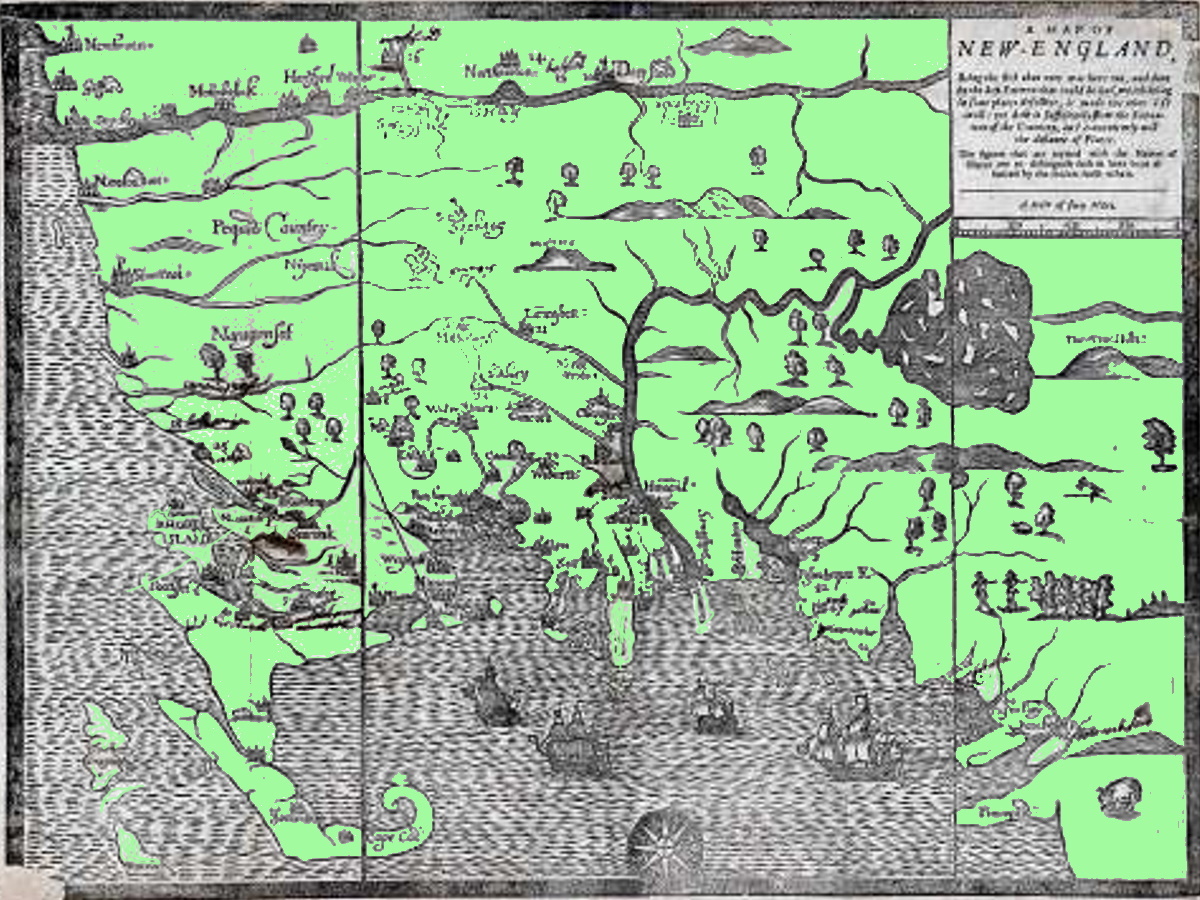
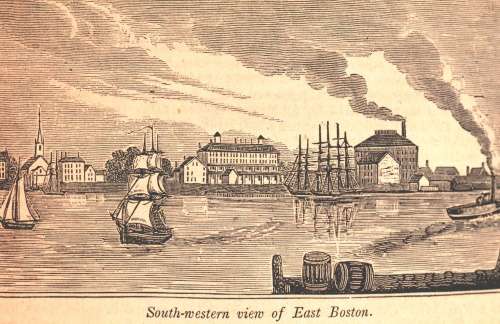

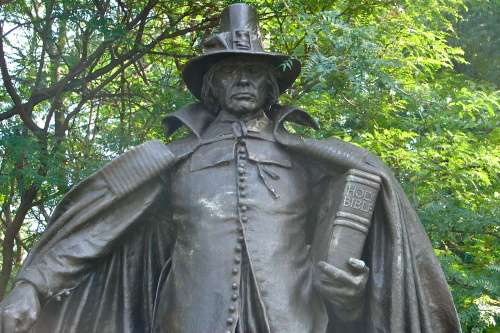


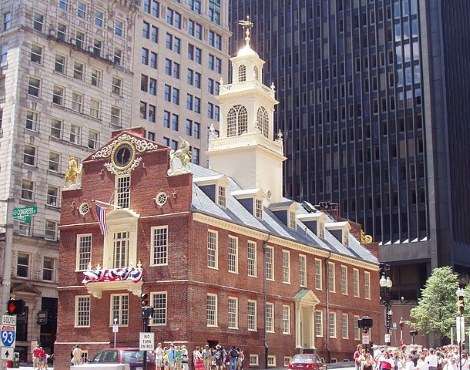
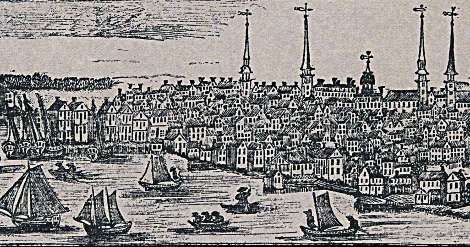
2 comments
There seem to be a few errors in this article.
Maverick did not settle first on Noddles Island; he built a house at Winnsemmet, which is now Chelsea. He moved to Noddles Island some years later.
Maverick was in fact a freeman of Massachusetts, granting him voting rights (See the Records of the Massachusetts Bay Colony, Oct 19, 1630). Though freemanship was eventually limited to church members, this was not so in these early months of the colony, and it appears that Maverick’s freemanship was never revoked.
By the way, “freeman” means that one can vote and hold office in the community, not that one is a church member, as stated above. Massachusetts Bay eventually required all freemen to be church members.
When Winthrop arrived in 1630, he and his “band” did not exactly “arrive and start running the Massachusetts Bay Colony,” as if this was a sort of takeover. There was no Massachusetts Bay Colony before Winthrop and his company arrived; it was granted by King Charles via a royal charter to a group of Puritan gentlemen. The royal charter overruled the previous charter that Maverick settled under. Winthrop was the second governor of the Company and the first one in Massachusetts.
In the early days of the colony Maverick worked with the new political power in the Bay, co-financing some projects. He also seemed to have run an inn or tavern; some people were levied fines for drinking to excess at Maverick’s place.
In the end, Maverick chafed under the Company leadership, as his philosophy differed from theirs. The Puritans were hoping to establish a community-focused form of purified (as they saw it) Christianity. Maverick, though an Anglican, was, I think, not an especially religious man, and certainly did not have the zeal to reform the English Church that these Puritans had. He and they fell out with each other, and Maverick joined a group in England trying to revoke the charter of the Massachusetts Bay Colony.
As far as his slave-holding, the fact that Maverick held slaves should not give us pause. Slavery was legal everywhere. Slavery was also not considered to be a moral wrong in the 17th century — a historical fact that is painful to us now, but is necessary to understand if we’re to understand this era.
What might give us pause is the fact that Samuel Maverick directed one of his male slaves to rape one of his female slaves, apparently in order to impregnate her and gain more slaves for Maverick. See: “The Cause of Her Grief”: The Rape of a Slave in Early New England, by Wendy Anne Warren, published in The Journal of American History, Vol. 93, No. 4 (Mar., 2007).
Just a point of clarification: We do not state that Maverick first settled on Noddles Island. We are aware he first lived in Chelsea. The point of the story was NOT a biography of Samuel Maverick, but the changes he saw in New England during his time here.
Comments are closed.